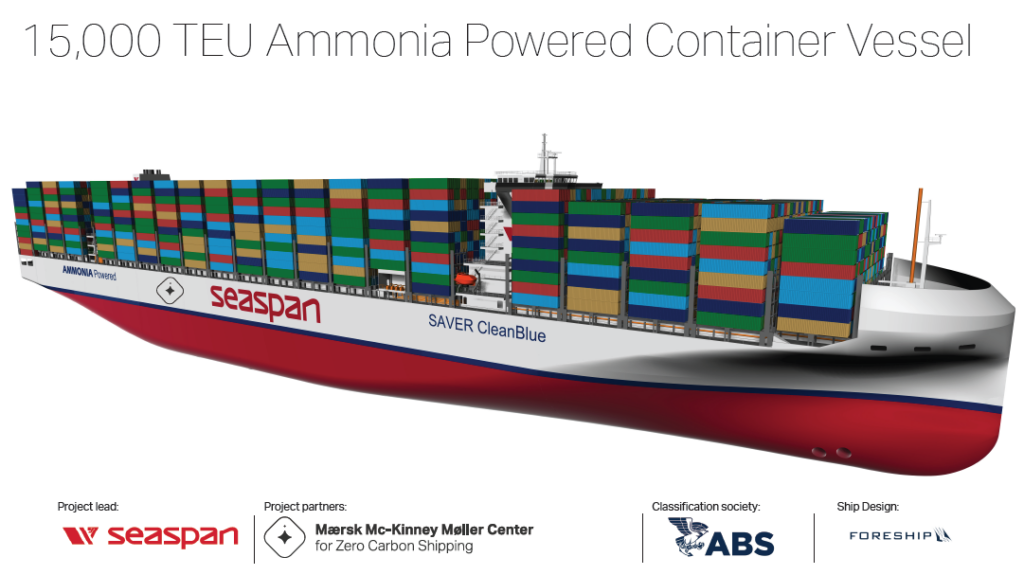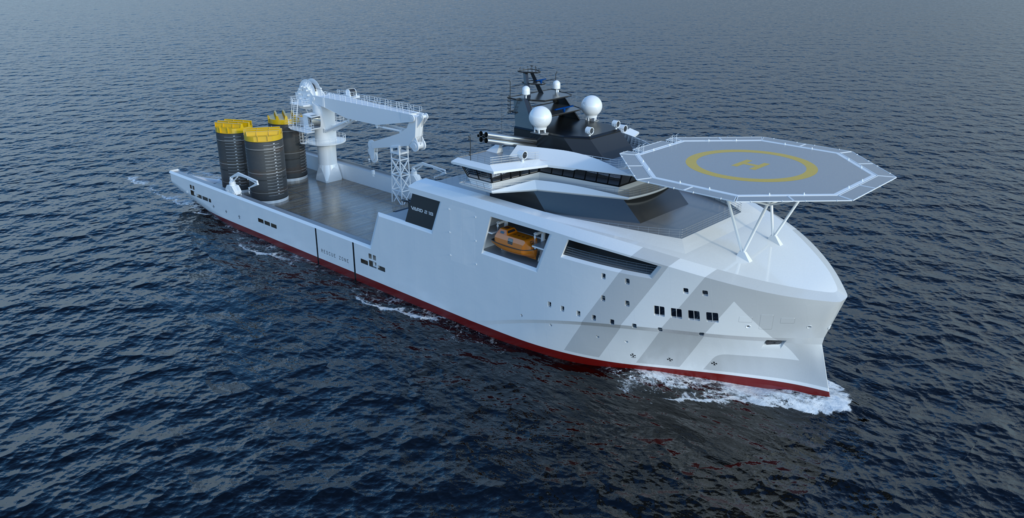Maritime momentum builds: ammonia-powered container ships, offshore service vessels
By Geofrey Njovu on August 07, 2023
Seaspan Corporation & partners: Approval in Principle for ammonia-powered container vessel

Seaspan Corporation, the Maersk Mc-Kinney Moller Center for Zero Carbon Shipping (MMMCZCS) and Foreship have been granted Approval in Principle (AiP) by the American Bureau of Shipping (ABS) for the design of a 15,000 TEU ammonia-powered container vessel.
The project was started in 2022 and sought to address the safety objectives, identify potential hazards and the impact on vessel performance of using ammonia fuel. Thus far, fuel range & endurance analysis, ammonia tank & system assessments, main machinery & electrical system design, and initial vessel stability calculations have all been completed.
The 15,000 TEU vessel has been designed as a potential receiver of ammonia fuel from bunker vessels. Later this year, MMMCZCS will publish a public report on the new vessel, featuring the detailed concept design, the ammonia safety case, and the risk assessment outcomes. The project will now focus on taking steps towards potential commercialization of the vessel.
Developing an ammonia-fueled vessel is a key step in decarbonizing the maritime sector and is part of our decarbonization strategy. Combining our knowledge and experience of designing and operating container ships with major partners at the MMMCZCS ensures a safe and practical ammonia-fueled design for the container sector, providing confidence for ammonia suppliers and original equipment manufacturers to invest in this fuel.
Torsten Pedersen, Seaspan COO in his organisation’s official press release, 26 July 2023
This initiative is closely linked to the Singapore Ammonia Bunkering Feasibility Study (SABRE) consortium, which aims to establish an ammonia supply chain in Singapore.
AiP granted for small-scale ammonia-powered container vessel
The ABS has also granted AiP to Korea Maritime Consultants (KOMAC) for the design of a 3,600 TEU ammonia-fuelled container ship. The new design seeks to address the need for small-scale, ammonia powered vessels. The AiP indicates that the design meets safety and reliability demands for ammonia-fuelled vessels.
Ammonia offers both significant potential to contribute to shipping’s emissions reduction challenge and significant challenge due to its toxic properties. ABS is leading the industry in developing solutions to this safety challenge and supporting first movers like Komac to take advantage of ammonia’s zero-carbon potential.
Panos Koutsourakis, ABS VP, Global Sustainability in ABS’ official press release, 11 July 2023
KOMAC offers Korea’s best engineering and technology services for shipbuilding. By providing these services to international and domestic small and medium-sized shipyards, we are supporting the revitalization of these important facilities.
Lee Sung-Ryong, Head of KOMAC’s think tank in ABS’ official press release, 11 July 2023
New ammonia-powered offshore wind service vessel

The Blaavinge consortium & DNV have unveiled an ammonia-powered offshore wind service vessel design. This is part of a pilot project seeking to “realise zero-emission solutions for the installation and operation of floating offshore wind turbines”. Renewable ammonia-powered service vessels have the potential to reduce emissions from installation and operation of offshore wind projects.
Subject to pilot outcomes, the project partners have ambitions to use the ammonia-powered service vessel for the installation and operation of their floating offshore wind project at Utsira Nord. The Utsira Nord offshore wind farm project (1.5 GW at full scale) will be developed by Ocean Winds, Statkraft and Mainstream Renewable Power.
Blaavinge is led by two Norwegian renewable energy companies (Fred. Olsen Seawind & Hafslund), as well as Denmark-based offshore wind developer Orsted. Other members of Blaavinge’s pilot project are Yara, Karmsund Havn, Azane, Wärtsilä, Norwegian Maritime Directorate, ABB, DNB, Corvus Energy, Vard and Amon Maritime.
Installation and maintenance of the offshore wind farms requires extensive use of offshore vessels and especially anchor handling vessels. 100 percent emission reduction can only be achieved through carbon-neutral fuels, such as green ammonia. If we are successful with the project, it means that the installation of offshore wind turbines can be done with significantly lower greenhouse gas emissions than is possible today.
Erlend Gjelstad Jakobsen, Hafslund’s Senior Project Developer, Offshore Wind, in Vard’s official press release, 28 June 2023
The pilot project is part of the Green Shipping Program (GSP) which aims to contribute to “Norway developing the world’s most efficient and environmentally friendly shipping.”
Norway has particularly favourable conditions for the production and distribution of green ammonia, as we have access to clean, electric power and we have leading expertise in the production of ammonia. In addition to realizing emission reductions for floating offshore wind in Norway, we see a potential for further use and application of the technology in the Norwegian and international offshore industry.
Magnus Eide, DNV & GSP Project manager, in Vard’s official press release, 28 June 2023